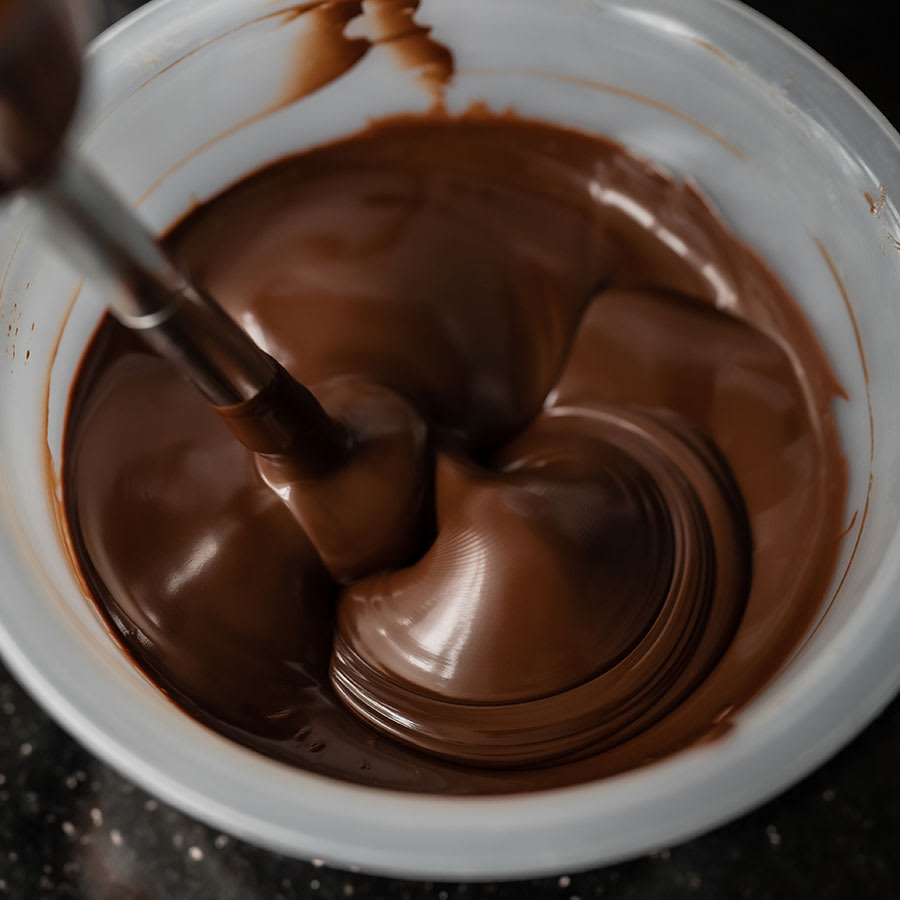You are using an outdated browser. Please upgrade your browser to improve your experience and security.
Chocolate Emulsion
What is an emulsion?
The idea of an emulsion is to mix together at least two ingredients that would naturally repel each other, such as water and oil. Without going into technical detail, we will show you how to master this technique for successful desserts.
Emulsifying is an almost daily task for chocolatiers and pastry chefs. A part of the vast majority of recipes, emulsions give lots of recipes and creations the creamily melt-in-the-mouth, thick, smooth texture that consumers expect and makers aim for. Emulsions also have a role to play in preserving chocolate bonbons.
Although emulsions have been used for a very long time, lots of people struggle with the technique.
How to make an emulsion
Emulsions are prepared using at least two ingredients with different characteristics, one fat-based, the other water-based.
Technically, the word “aqueous” is used for the water-based part of the mixture.
The aqueous phase might include milk, cream, fruit purée, syrup, crème anglaise, infusions or water. All these ingredients are mostly water (although the exact percentage can vary).
The oily part, called the fat-based phase, can be any oily ingredients your recipe may include, such as chocolate, praliné, almond paste, butter, oil and, of course, cocoa butter.
Without a considerable amount of friction (or a “vortex”, as this is known), the two non-miscible elements can’t fuse together.
As well as the famous example of mayonnaise, chocolate ganache is a perfect example of an emulsion. A well emulsified ganache is viscous and creamy. It is smooth, with a shiny elastic center, and it is a very popular part of many desserts and chocolate preparations. A mixture in which the fat- and water-based parts haven’t been emulsified is said to be "out of phase".
For ganaches, it is essential to mix the aqueous phase into the fat phase, the chocolate. Cocoa butter crystallizes at room temperature. To emulsify it, you have to make it liquid by melting the chocolate, for example, in a bain-marie. The idea is to make it hotter than its main melting point, which is around 95°F (35°C).
Making a good chocolate emulsion
For an emulsion to work, it needs to be stirred vigorously at the start of the mixing process, but it also requires surfactants and lecithin, chocolate’s emulsifying ingredient.
Surfactants are contained in milk or cream proteins. They bond together the aqueous (hydrophilic) and lipid (lipophilic) parts, helping to make the emulsion more stable.
For ganaches or pralinés, we have to do the process for mayonnaise in reverse (by slowly enriching the fats with water), so we start with a saturated fat phase. As a result, it’s quite normal to see the mixture separate early in the process.
Although it might look worrying, this texture is a sign that you aren’t adding water too quickly, and that the mixture is still perfectly viscous and elastic. Because it has the right texture, it can create or even increase the amount of friction needed for a good emulsion.
Final thoughts about emulsions
The word “emulsified” is sometimes misapplied to mixtures made using a siphon. We actually whip up this type of preparation, because we want to incorporate air to make it frothy (for example for foams or ice creams). A béarnaise or chocolate mousse is a whipped emulsion, whereas a ganache is an emulsion.
Emulsions make it possible to perform pastry- and chocolate-making wonders, delighting even the most demanding connoisseurs. You simply can’t overlook it, so master it and enhance your desserts, gateaux, sponges, creams, mousses and many other delicious preparations!

